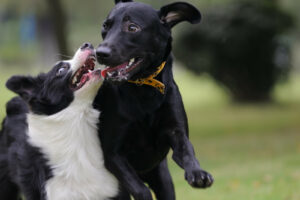Barks Blog
Being Social…..and Polite

I have seen many posts on social media recently by dog owners regarding ‘out of control’ dogs in public spaces. I don’t recall this much of an outcry 3, 5 or way back 10 years ago, so is it really warranted? Or is it simply the case that now we have a facilitated platform for such views?
It’s only a personal opinion, but in my view the simple answer is, yes, it is warranted. The great thing is that modern society largely embraces canine culture. There’s still a lot of room for improvement, but we can now take our dogs places. The flip side of this great opportunity is that there’s scope for abuse and the downside for dog owners is that public spaces (parks, beaches, areas of towns etc.) risk becoming more restricted due to the actions of an irresponsible few.
We know how great dogs are for the soul, they lift our spirit, make us smile, enhance and enrich our lives. We must also remember though that not everyone shares our love. It’s easy to forget that some people may be intimidated by dogs, may have had negative past experiences or simply may just not like them! When we share public spaces, we should be mindful of this and not assume a universal adoration of all things dog. If our dogs are particularly bouncy, liable to leap or not quite 100% on recall, well, that’s fine but maybe don’t allow them off-leash in the midst of a densely populated area where they’re likely to bowl over half the park. Remember, you may fall foul of local laws too if you are not keeping your dog under control (or presumed control) in a public space.
So what about the old, ‘It’s okay, he’s friendly’ adage? How many times have you heard that? If everyone thought a little more about the responding dog, we’d probably have fewer dog on dog incidents. Many owners walk their dogs on leash for a reason, even in parks or areas where dogs may be allowed off leash. Maybe the dogs are especially shy, maybe they’re starting some training, maybe they’re actually trying to stay away from you or perhaps they just aren’t ready to interact or be off leash yet. I would suggest if another dog is on leash, that we keep ours on leash and do not allow him to charge up and say hello. This can be really challenging, intimidating and threatening to the ‘recipient.’ Sometimes an interaction like this may lead to the respondent dog reacting aggressively and the corresponding owner being blamed. But how is it their fault when they were not the instigator and were just trying to stay safe and out of everyone’s way? Many of my clients utilize the colored harnesses and collars designed to inform others of the dog’s emotional state, e.g. nervous, reactive etc. or to repel any suspecting individual, e.g. ‘keep away’, ‘in training’ etc. Yet I have, on several occasions, encountered inquisitive individuals come up deliberately to these owners to try to interact with their dogs and inquire why the dog is nervous, why they should stay away etc.
If we have dogs who require a little more specialist work, e.g. reactive dogs, we cannot be off guard. From the owner’s point of view, this may entail not placing the dogs in uncomfortable situations so they feel forced to react i.e. crowded, heavily populated spaces, not allowing dog contact beyond what is a comfortable remit for the dog, and using a long line if off-leash exercise is not yet safe or feasible. Hopefully, behavioral work will be conducted at the same time. Similarly, other dogs who are not quite there with training, e.g. vocal dogs, dogs who pull excessively, or will not readily come back should not be set up to fail by taking them to places where they will struggle. This might include over-populated environments with lots of social distractions which will increase arousal, make it hard for the dog to respond and, consequently, make it appear to a wider audience that your dog is ‘out of control’ when really he is just struggling with his environment.
Another issue is in-season bitches and entire males. We have a responsibility to these dogs if we decide to keep them intact. A bitch is in season between two and four weeks and, obviously, during this time she will be heavily attractive and responsive to entire males.Is it responsible to walk a bitch in-season off-leash in a public space, rather than on-leash for this short duration in a less open environment. Owners of entire male dogs have a responsibility too. If you know your dog, you know exactly when he has picked up a bitch scent. At this point, the dog must be put on a leash.
We have the luxury of having dogs in our lives, but we must not take this for granted or exclude the feelings of others who may not be dog lovers. Nor should we assume that every dog is as easy going as our own. If we take the trouble to think a little more about what other owners are doing and why, plus also educate our own dogs with regard to training and behavior, then our social coexistence would surely be improved.
